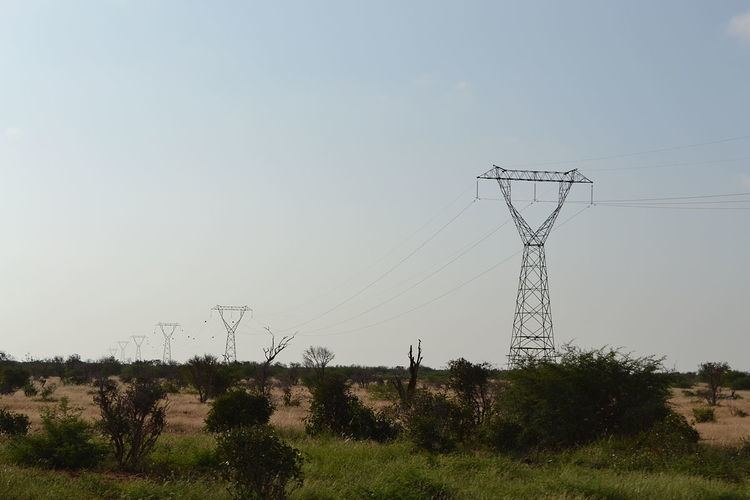 | ||
Energy in Kenya describes energy and electricity production, consumption, import and export in Kenya. Kenya's current effective installed (grid connected) electricity capacity is 2,177.1 MW as at March 2015. Electricity supply is predominantly sourced from hydro and fossil fuel (thermal) sources.
Contents
- Sources of electricity
- Renewable energy
- Utilities
- Imports
- Reserves
- Production
- Challenges
- Future sources of electricity
- Eastern Africa Power Pool EAPP
- Geothermal power
- Nuclear power
- Carbon emissions
- References
Just until recently the country lacked significant domestic reserves of fossil fuel. The country has over the years had to import substantial amounts of crude oil and natural gas. This might change with the discovery of oil reserves in Kenya, which relied on oil imports to meet about 42 percent of its energy needs in 2010. As of the end of June 2016, 55% of Kenyans were connected to the National grid, which is one of the highest connection rates in Sub-Saharan Africa.Per capita consumption in domestic households however, remains low.Kenya Power
Sources of electricity
Capacity
* Energy Regulatory Commission. Source:[2]
Generation
Renewable energy
Kenya is currently the largest producer of geothermal energy in Africa. It is one of two countries in Africa that produce geothermal energy, the other being Ethiopia. In 2010, geothermal accounted for almost 20 percent of Kenya's total electricity generation. The country has the potential to produce 10,000 megawatts of geothermal-powered electricity, according to Kenya's state-owned Geothermal Development Company. Total renewable energy capacity is at 60%. With most of that coming from Hydro-Power.
Utilities
In Kenya, there are plans by the government to end the monopoly of the electricity distribution market but until that happens, power distribution is only held by one company:
Imports
Kenya has one of the largest crude oil refineries in East Africa, the 90,000-barrels-per-day (bbl/d) Mombasa refinery. The refinery typically operates below capacity and processes Murban heavy crude from Abu Dhabi and other heavy Middle-Eastern crude grades. In 2011, Kenya imported about 33,000 bbl/d of crude oil entirely from the United Arab Emirates, according to the Kenya National Bureau of Statistics (KNBS). Kenya imported 51,000 bbl/d of refined oil products in 2011, according to KNBS. Kenya has a product pipeline system that transports petroleum products from Mombasa to inland areas. Most of the imported and/or domestically refined products are sold in Kenya's major cities and the remainder is sent to neighbouring countries via trucks. In 2011, Kenya consumed around 81,000 bbl/d of oil products.
Reserves
In mid – 2012 oil was discovered in Kenya. This came after a long time of disappointing exploration activities in Kenya. The reserves became commercially viable after it was confirmed that there were around 300 million barrels worth of reserves.
As of January 2014, Tullow said Kenya's Northern Basin could have an excess of 1 billion barrels of oil. Kenya's deposits may top 10 billion barrels.
Production
If the Kenya-Uganda pipeline was connected it could pipe 500,000 barrels of oil per day. Kenya could envisage exporting oil as early as 2016.
Challenges
Fuelwood demand in the country is 3.5 million tonnes per year while its supply is 1.5 million tonnes per year. The massive deficit in fuelwood supply has led to high rates of deforestation in both exotic and indigenous vegetation resulting in adverse environmental effects such as desertification, land degradation, droughts and famine.
Future sources of electricity
* Kenya electricity sector. Source:[3] [4]
* International Atomic Energy Agency (IAEA). Source:[5]
Eastern Africa Power Pool (EAPP)
7 Countries came together because they saw mutual benefit in having one power pool they were:
However more countries were included:
The objective of the Eastern Africa Power Pool (EAPP) is to increase the volume and reduce the cost of electricity supply in Kenya; and to provide revenues to Ethiopia through the export of electricity from Ethiopia to Kenya.
In the first phase the Kenyan grid is connected to the Ethiopian grid.
Kenya also plans to be connected to the South African grid by 2015 through Tanzania which is also part of (SAPP).
Geothermal power
Geothermal power plants, which convert steam generated from hot rocks deep underground into electricity, have a prominent place in Kenya’s overarching development plans. These include the Vision 2030, the NCCAP, and the current ‘5000+ MW in 40 months initiative’. Geothermal power has the potential to provide reliable, cost-competitive, baseload power with a small carbon footprint, and reduces vulnerability to climate by diversifying power supply away from hydropower, which currently provides the majority of Kenya’s electricity. Kenya has set out ambitious targets for geothermal energy. It aims to expand its geothermal power production capacity to 5,000 MW by 2030, with a medium-term target of installing 1,887 MW by 2017. As of October 2014, Kenya has an installed geothermal capacity of approximately 340 MW. Although there is significant political will and ambition, reaching these ambitions is a major challenge. Kenya Electricity Generating Company (KenGen) and Geothermal Development Company aim at raising the country's geothermal output from the current 593MW, to 1 GW by the year 2018 and 5 GW to the grid by 2030.
Nuclear power
In September 2010 Former Energy and Petroleum Ministry PS Patrick Nyoike announced, that Kenya aims to build a 1,000 MW nuclear power plant between 2017–2022. For Kenya to achieve middle-income status nuclear energy has been determined to be the best way to produce safe, clean, reliable and base load (constant supply) electricity. The projected cost using South Korean technology is US$3.5 billion.
Carbon emissions
Kenya emits .03 percent of the world carbon dioxide, which is about 12.62 (Million Metric Tons of CO₂).
